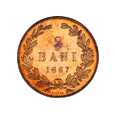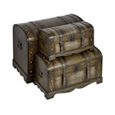EMIL REBREANU`S HORSEWHIP
Text: Cornel C. Ilie, Ionuț Drăgoiescu / Foto: George Nica
The horsewhip of braided leather, with a silver handle decorated with vegetal motifs, entered the patrimony of the National History Museum of Romania in 1984, as a donation to our institution from Mrs. Emilia Cofariu-Dumbreanu, who also left us the touchy story of the horsewhip. At the end of 1916, Emil Rebreanu, a sub-lieutenant in the Austrian-Hungarian army, arrives in the village of Ibănești (Mureș). The schoolteacher in the village, Dumitru Cofariu, was under the surveillance of the imperial authorities because he manifested his sympathy for the Romanian army after it entered Transylvania in the summer of 1916. Knowing that the schoolteacher was in danger, Emil Rebreanu urged him to cross the mountains, at least for a while, together with his family (he had a wife and six children). He promised him that he would take care of his old mother and the household. Cofariu listened to his advice and when, after a little while, he went back to Ibănești, he saw that the young officer had kept his promise. As a token of her gratitude, the schoolteacher’s wife, Sabina Cofariu, who was pregnant, promised him that their future baby will be named Emil or Emilia, depending on its sex. Appreciating this proof of gratitude, Emil Rebreanu gave Sabina his own horsewhip (for the case in which the new born was a boy) and a pair of gold earrings (if the baby was a girl). After a short while, a girl was born, she was named Emilia and the objects offered by the young officer got into her possession.
EMIL REBREANU
Emil Rebreanu was born on December 17th 1891, in the village of Maieru (Bistrița); he was the fifth of the 14 children of the schoolteacher Vasile Rebreanu and his wife, Ludovica. He attended the first two classes of primary school at Prislop, then he was transferred to the school in Năsăud. After leaving elementary school, he was transferred by his father to the Romanian high-school in Năsăud, then to the Hungarian one in Bistrița. Because of his family’s financial difficulties, he had to interrupt his studies. In the autumn of 1910, Emil was employed as the assistant of a notary public in Pata, a village near Cluj. Determined to complete his studies, he enrolled in the high-school in Turda, then in the one in Șimleu, where he managed to pass the Baccalaureate exam. He intended to continue his education with academic studies of Law.
After the war broke out in the summer of 1914, Emil was summoned to Bistrița for recruitment and sent to the military school of artillery in Târgu Mureș. In March 1915, Emil Rebreanu’s unit was sent to fight on the battlefield in Galicia. Cadet Rebreanu’s first letter from the battlefield, written on “the chase of a cannon”, was sent on April 5th 1915. After a short while, he was advanced to the rank of sub-lieutenant and sent to the Italian battlefield, where he remained up to the spring of 1916. As an officer, he got himself noticed by his fair behavior towards his subordinates, whereas on the battleground he was remarked for his brave feats, for which reason he was decorated with the “Gold medal for bravery”.
In the summer of 1916, Emil was transferred to Tirol and, from here, to Wolhynia, on the Eastern battlefield. The young sub-lieutenant was enrolled in the 16th Infantry Brigade quartered at Ghimeș and his regiment was sent to fight on the Romanian battlefield. This is the moment when Emil Rebreanu’s ordeal starts, as he is in the situation to fight against the Romanians from the Old Kingdom. His decision to desert from the Austrian-Hungarian army in order to cross to the Romanians’ side is understandable. On the night between the 10th and the 11th of May 1917, Emil left the infirmary of the 16th Infantry Brigade, where he was hospitalized, and tried to slip through the barbed wire fences, but he was caught by a patrol of officers.
On the 11th-12th of May 1917, Emil Rebreanu was judged by the Court Martial of the Brigade, charged with the crime of desertion and espionage and sentenced to death by hanging. The execution took place on the 14th of May 1917, very close to the border between Austria-Hungary and Romania. Rebreanu asked to be buried over the border, in Romanian soil, but his request was denied. His death was announced to his family by the Croatian Jovan Kurici, his orderly. After the war, his brother, the great writer Liviu Rebreanu, manages to identify the place of the execution and the grave, and fulfills his last wish. The exhumation and re-interment of Emil’s remains, from Ghimeş to Palanca (Bacău County), were made on October 2nd 1921, in an official manner, with the support of the society called “The tombs of the soldiers killed in the war”. Moreover, a commemorative monument was erected on this spot.
EMIL REBREANU AND “FOREST OF THE HANGED”
Forest of the Hanged originated in a photograph that a friend of mine showed me at the end of 1918. The photo depicted a forest full of hanged Czechs, behind the Austrian battlefield towards Italy. My friend was going to participate in the Peace Conference, where the picture was going to demonstrate how the Czechs were treated by the rulers of the Austrian monarchy. That photograph strongly impressed me and haunted me for a long time. I had heard that many Romanians had been executed in a similar way. I had been told that even in Bistrița, so in my own country, many priests and peasants from Bucovina had been hanged (...). A few months later, I found out that a brother of mine, about whom my family thought that he was a prisoner somewhere in Russia and who was a student who had become an artillery officer in the Austrian army, brought to fight on the Romanian battlefield against the Romanians, had tried to cross to the Romanians’ side, but had been caught, sentenced and executed by hanging as early as May 1917.
Neither the place where he was executed, nor the circumstances or any details were known. In that turbulent epoch, when hostilities had not completely ceased for us yet, one could not find any kind of information. A few months had to pass until I could discover the approximate area where this tragedy of a 25 year-old young man had happened. Meanwhile, I had finished the transcription of Ion and now I used to spend all my nights in front of my desk, tormented by “Forest of the Hanged”. I started the novel for almost four times, writing between thirty and fifty pages. However, I felt that I had found neither the pace, nor the atmosphere. Every night I was struggling to write, but my work was in vain. Nevertheless, while I was writing, in the deadly silence, I started to hear some light taps on my window, as delicate as the touch of immaterial fingers. I used to open the window, searching the darkness. There was nobody and nothing… however, when those mysterious taps repeated for many nights, insistently – because, I’ll say it again, I am pious and superstitious – I told myself there could not be anything else but my brother’s soul, which was asking for the Christian care that it had obviously been deprived of.
And then (in May 1920, n.n.), I started to look for my hanged brother’s grave, determined to find it, no matter what. After a lot of investigations and many adventures, I finally found it at Ghimeș, in an orchard, on the edge of the former border. The place was not even marked. Only with the help of the gravedigger in the village could I establish where my brother had been hanged and buried. I went to the house of the one who was the mayor back then, where he was judged and sentenced. I entered the little room where he had spent his last hours and from where he had left for the final torture. I went to the neighboring village, to Făget, where he had his last residence. I met the Romanian priest who was his friend, but who had not been allowed to accompany him to death. I talked to a lively, pretty peasant girl, in whose possession I found a few letters from him. The mayor gave me his peakless cap that he had been forced to change with a civilian hat when he had set off on his last earthly road. Then I exhumed him and I moved his remains across the stream that used to be the border, on the ancient Romanian land, as he had asked in his last moments of life and had been refused.
After that I could write Forest of the Hanged in peace. The mysterious taps on the window ceased and I found a beginning that pleased me and a significance for the main character of the novel... The plot of Forest of the Hanged, a cerebral construction at first, humanized itself only at the interference with real life and with the land. Without my brother’s tragedy, “Forest of the Hanged” would have been either a total failure or an anemic, bookish construction, like all the books conjured up in one’s head, in front of a desk, devoid of the living and refreshing sap that only life experience generates in the creator’s soul...”. (Liviu Rebreanu, Diary I, Minerva Publishing House, 1984)
1917: a dramatic year for the Rebreanu family
Emil’s execution was not the only tragedy in the Rebreanu family in 1917. In the same year, in March, Sever Rebreanu died of pneumonia at the age of 13. Another brother, Virgil, voluntarily enrolled in the Austrian-Hungarian army. He was wounded in 1916 and, although he was not completely recovered, he was sent to the Russian battlefield, where he was severely wounded by the explosion of a bombshell. He remained paralyzed and died in a hospital in Budapest on May 16th 1917 (two days after his brother was executed).













